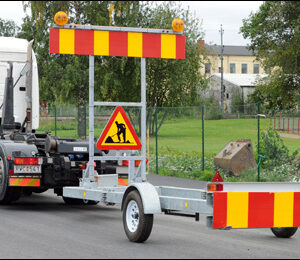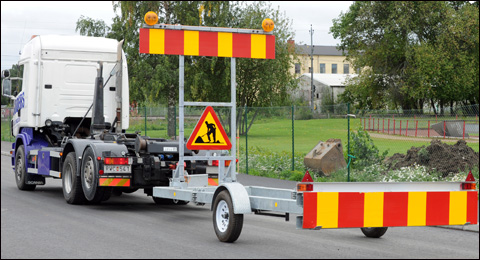TTMA-100
TTMA-100
TTMA-100, a towed crash attenuator (TMA – Truck Mounted Attenuator), the first tow bar and TL-3 approved TMA that can be used for almost any vehicle in your trailer park from 9000 kg GVW weight and up.
Product Description
TTMA-100 Trailer Truck Mounted Attenuator
TTMA-100, a towed TMA – Truck Mounted Attenuator, the first towled system tested to TL-3 and approved TMA, that can be used for almost any vehicle in your truck park from 9000 kg GVW weight and up.
By using an 8-ton standard hook, the 660 kg heavy TTMA-100 be fitted in minutes, without any modifications to the towing vehicle.
TTMA-100 offers the most affordable and most flexible TMAsäkerheten on the market today.
Features and Benefits
- The patented energyabsorbingprosecess use the trailer frame as a shock absorber , which simplifies the design and reduces the cost.
- Meets all requirements and options according to NCHRP 350 Test Level 3 (TL- 3) , in that the towing vehicle is blocked to eliminate all forward motion ( the worst scenario ) .
- Provides continuous protection at all times and speeds : there is no need to raise the TMA to a vertical position during transport ; no Headroom problems.
- Can be used on any vehicle that weighs 9000 kg or more, and that has a Type VBG 8 -ton standard hook mounted .
- No maximum weight limit on the towing vehicle.
- Specifically, the towing vehicle is not necessary. Replacement of the towing vehicle goes in a few minutes .
- Fully galvanized against moisture and corrosion protection.
- Can be equipped with adjustable arrow plate or message sign (optional).
- Crash tested .
- Hook weight of only 68 kg , which means that the towing vehicle’s loading capacity does not decrease significantly.
- Serves as the trailer any time and does not change the towing vehicle’s normal operating capacity.
Specifications
- W 244 cm x H 79 cm x L 717 cm
- 657.71 kg (91 kg hook weight )
- 793.8 kg including arrow board (182 kg bullet weight )
- Hook height : 49.5 cm – 81.3 cm
- Hot dip galvanized.
- Meets NCHRP 350 TL -3 ( Passed test level: 3-50 , 3-51 , 3-52 , 3-53 )
- VBG towring
- VBG for lights
Have passed all NCHRP 350 tests as required , and also a volunteer crash test level 3 (TL- 3) where the support vehicle is locked for all forward motion ( worst case scenario) and the impact speed is 100 km/h


